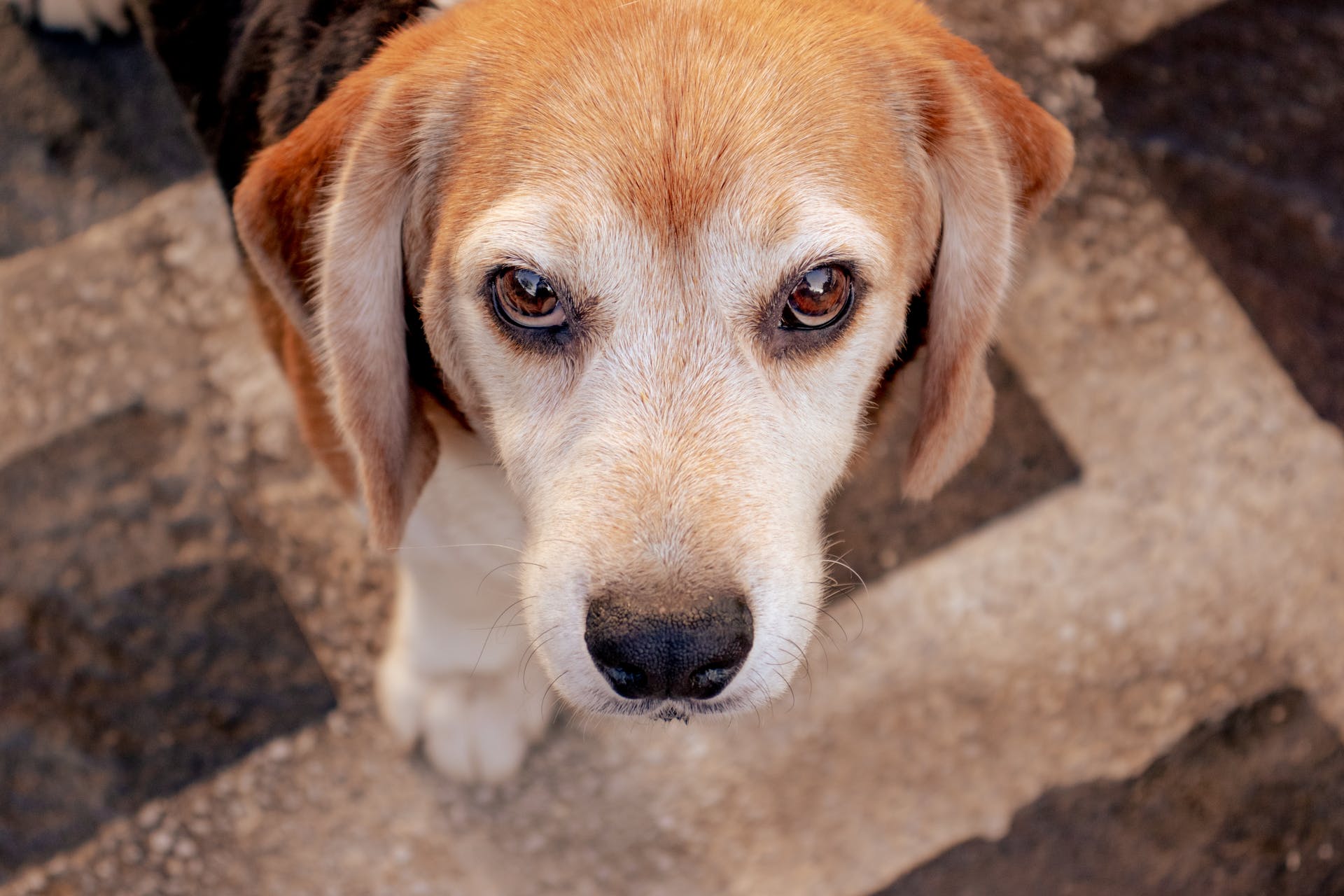
The Vizsla Hungarian Pointer is a breed that's steeped in history and tradition. Originating in Hungary in the 10th century, this dog was bred to hunt game, and its name "Vizsla" roughly translates to "seeker" or "hunter".
Vizslas are a medium-sized breed, typically weighing between 45-65 pounds and standing between 21.5-24.5 inches tall. They have a short, smooth coat that's usually a rich golden color.
One thing to keep in mind is that Vizslas are high-energy dogs that require regular exercise to stay happy and healthy. They need at least an hour of physical activity per day, and they love to run, swim, and play fetch.
Origin and History
The Vizsla, also known as the Hungarian Pointer, has a rich and fascinating history that spans centuries.
The breed's ancestors were hunters and companions for the Magyar, a nomadic tribe that eventually settled in what is now known as Hungary. They were likely descended from the ancient Transylvanian Hound and the now-extinct Turkish yellow dog.
The Vizsla is most associated with the Puszta region in Hungary, a central area with diverse agriculture and a variety of game, which helped to create a dog with a superior nose and hunting ability suited to all weather extremes.
After World War II, the breed suffered greatly and was almost extinct, with owning a Vizsla considered a bastion of aristocracy not favored by the Russians who took control of Hungary after the war.
The breed was saved by owners who emigrated to other areas in Europe and abroad, and it was these dogs that formed the foundation of the modern breed.
The Vizsla arrived in the United States during the 1950s, where hunters were impressed by his hunting prowess, particularly his stamina in hot weather.
The breed was an all-rounder, searching diligently, marking and retrieving from land and water, and paired with his friendly disposition, he was easy to keep as a family companion too.
You might like: German Shorthaired Pointer Hunting Dogs
Breed Information
The Hungarian Vizsla is a medium-sized dog with a short, smooth, and dense coat in a solid golden rust color. They originated in Hungary and are part of the Sporting breed group.
Their lifespan is relatively long, ranging from 10-15 years, and they are generally healthy, but can be prone to certain health conditions such as hip dysplasia, elbow dysplasia, eye problems, and allergies.
Here are some key stats about the Vizsla breed:
They are friendly, intelligent, and active dogs, requiring high exercise needs and easy training.
Breed Classification
Vizslas belong to the Sporting Group, which is a category of well-rounded companions that excel in various activities such as hunting, dog sports, and therapy work.
Their versatility is unmatched, making them an excellent choice for active families who love the outdoors.
Vizslas are medium-sized dogs with a short, smooth, and dense coat in a solid golden rust color.
They are known for being friendly, intelligent, and active, which makes them a joy to be around.
Their high exercise needs require regular physical activity, such as hiking, running, or playing fetch.
Training is also a breeze, as Vizslas are easy to train and respond well to positive reinforcement methods.
Here's a quick rundown of Vizsla breed characteristics:
Breed Organizations
Reputable breeders are committed to breeding healthy, well-socialized puppies that will make great companions. They screen their breeding stock for health problems, socialize their puppies from a young age, and provide lifetime support.
Finding a reputable breeder is one of the most important decisions when bringing a new dog into your life. Backyard breeders, on the other hand, may not screen their breeding stock for health problems or socialize their puppies properly.
The Vizsla Club of America can help you find a reputable breeder.
Expand your knowledge: Vizsla Dog Health Problems
Temperament
The Vizsla's temperament is a unique blend of energy, sensitivity, and affection. They're naturally energetic animals that need plenty of exercise and stimulation to prevent destructive behaviors.
A Vizsla's high energy level can be a challenge, but with proper training and attention, they can thrive. They're excellent with children who are old enough to manage their high energy.
Vizslas are social dogs that form strong bonds with their owners, often earning the nickname "Velcro dogs" due to their love of sticking close. They can suffer from separation anxiety if left alone for too long.
Their lively and affectionate nature makes them a great fit for active families with energetic children. However, they do require a lot of exercise, over two hours a day, to keep them happy and healthy.
A Vizsla's sensitive nature means they need early socialization to become well-rounded dogs. This exposure to various people, sights, and experiences helps them develop good behavior and avoid potential issues.
Vizslas are known for being biddable, but some can be stubborn, excitable, or shy. With consistent training and positive reinforcement, you can help your Vizsla become a well-behaved companion.
Discover more: Hungarian Vizsla Training
Care and Maintenance
To keep your Vizsla happy and healthy, exercise is key. Give him at least two half-hour workouts daily in the form of walks, runs, or games of fetch.
A Vizsla needs a fenced yard where he can play safely, not just a yard with an underground electronic fence. This will protect him from other dogs entering the yard.
A Vizsla's short, smooth coat is easy to keep clean, but you should brush him with a soft brush and a hound glove to loosen dead hair and stimulate the skin.
Trim your Vizsla's nails once or twice a month to keep them from getting too long and clicking on the floor.
Grooming
The Vizsla's coat is relatively low maintenance, but it does need regular attention. A weekly brush is all it takes to keep their short, smooth coat looking its best.
Their coat can be prone to ticks and parasites, so it's essential to check it frequently. Regular inspections will also help prevent infections in their long ears.
A fresh viewpoint: Hungarian Vizsla Coats
A soft brush is perfect for the job, and a hound glove can help loosen dead hair and stimulate the skin. This will keep their coat looking healthy and shiny.
Trimming their nails once or twice a month is also crucial. If you hear their nails clicking on the floor, it's time for a trim.
Feeding
Feeding your dog is crucial for their overall health and well-being. A constant supply of fresh water is essential, along with a balanced diet that includes the right mix of nutrient groups.
Your dog's diet should be adjusted according to their age, build, metabolism, and activity level. A highly active dog will need more food than a less active one.
Feed your dog at least twice a day, in accordance with the feeding guidelines of their particular food. This will help ensure they're getting the right amount of nutrients.
The quality of dog food you buy also makes a difference - better food will go further in nourishing your dog and may require less overall. Measure your dog's food to avoid overfeeding.
To check if your dog is at a healthy weight, look for a visible waist and check their ribs by placing your hands on their back. If you can't feel their ribs without pressing hard, they need less food and more exercise.
Worth a look: German Shorthaired Pointer Diet
Frequently Asked Questions
What two breeds make a Vizsla?
The Vizsla is a cross between the ancient Transylvanian Hound and the Turkish yellow dog, with later influences from the German Shorthaired Pointer and Pointer. This unique heritage has shaped the Vizsla into a versatile hunting breed.
Are Vizslas related to pointers?
Yes, Vizslas can work as pointers, and their ancestors were likely brought to Hungary by the Magyars over a thousand years ago.
What is the difference between a shorthaired pointer and a Vizsla?
Vizslas are more affectionate, while German Shorthaired Pointers are more eager to please. Training-wise, Vizslas are slightly harder to train than German Shorthaired Pointers.
Is a Hungarian Vizsla a large dog?
No, a Hungarian Vizsla is a medium-sized dog. They are robust in build, but not large in size.
At what age do Vizslas reach full size?
Vizslas typically reach their full height between 12-15 months, but may take up to 2 years to reach their full adult weight.
Sources
- https://www.nylabone.com/dog101/vizsla
- https://www.purina.co.nz/find-a-pet/dog-breeds/hungarian-vizsla
- https://www.countryliving.com/uk/wildlife/dog-breeds/a40055996/hungarian-vizslas/
- https://www.thedogwalksme.com/2023/03/22/vizsla-basics-101-guide-to-everything-you-need-to-know/
- https://dogtime.com/dog-breeds/vizsla
Featured Images: pexels.com

